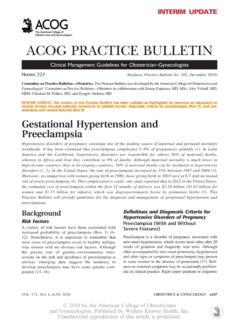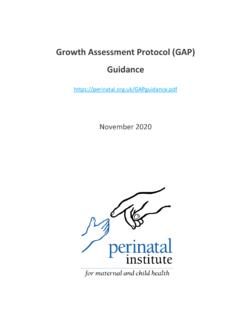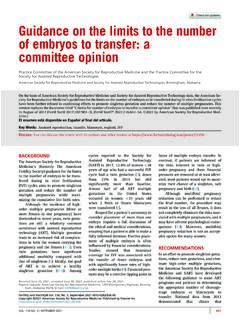Transcription of ACOG PRACTICE BULLETIN - EMCrit
1 Downloadedfrom BhDMf5ePHKbH4 TTImqenVAHxkFJp/XpPbpvbW1t75 OJlvmzWGQr43 PerAwsuYRBKEN5 EMaj9yQ4=on 01/11/2019 Downloadedfrom BhDMf5ePHKbH4 TTImqenVAHxkFJp/XpPbpvbW1t75 OJlvmzWGQr43 PerAwsuYRBKEN5 EMaj9yQ4=on 01/11/2019 ACOG PRACTICE BULLETINC linical Management Guidelines for Obstetrician GynecologistsNUMBER202 Committee on PRACTICE Bulletins Obstetrics. This PRACTICE BULLETIN was developed by the American College of Obstetricians andGynecologists Committee on PRACTICE Bulletins Obstetrics in collaboration with Jimmy Espinoza, MD, MSc; Alex Vidaeff, MD,MPH; Christian M. Pettker, MD; and Hyagriv Simhan, Hypertension andPreeclampsiaHypertensive disorders of pregnancy constitute one of the leading causes of maternal and perinatal mortality worldwide.
2 Ithas been estimated that preeclampsia complicates 2 8% of pregnancies globally (1). InLatin America and the Caribbean,hypertensive disorders are responsible for almost 26% of maternal deaths, whereas in Africa and Asia they contribute to 9%of deaths. Although maternal mortality is much lower in high-income countries than in developing countries, 16% ofmaternal deaths can be attributed to hypertensive disorders (1, 2). In the United States, the rate of preeclampsia increasedby 25% between 1987 and 2004 (3). Moreover, in comparisonwith women giving birth in 1980, those giving birth in 2003were at increased risk of severe preeclampsia (4). This complication is costly: one study reported that in 2012 in theUnited States, the estimated cost of preeclampsia within the first 12 months of delivery was $ billion ($ billion forwomen and $ billion for infants), which was disproportionately borne by premature births (5).
3 This PRACTICE Bulletinwill provide guidelines for the diagnosis and management of gestational hypertension and FactorsA variety of risk factors have been associated withincreased probability of preeclampsia (Box 1) (6 12).Nonetheless, it is important to remember that most casesof preeclampsia occur in healthy nulliparous women withno obvious risk factors. Although the precise role ofgenetic environmental interactions on the risk and inci-dence of preeclampsia is unclear, emerging data suggestthe tendency to develop preeclampsia may have somegenetic component (13 16).Definitions and Diagnostic Criteria forHypertensive Disorders of PregnancyPreeclampsia (With and WithoutSevere Features)Preeclampsia is a disorder of pregnancy associated withnew-onset hypertension, which occurs most often after20 weeks of gestation and frequently near term.
4 Althoughoften accompanied by new-onset proteinuria, hyperten-sion and other signs or symptoms of preeclampsia maypresent in some women in the absence of proteinuria(17). Reliance on maternal symptoms may be occasion-ally problematic in clinical PRACTICE . Right upper quad-rant or epigastric pain is thought to be due to periportaland focal parenchymal necrosis, hepatic cell edema, orGlisson s capsule distension, or a combination. However,there is not always a good correlation between thehepatic histopathology and laboratory abnormalities(18). Similarly, studies have found that using headacheas a diagnostic criterion for preeclampsia with severefeatures is unreliable and nonspecific. Thus, an astuteand circumspect diagnostic approach is required whenother corroborating signs and symptoms indicative ofsevere preeclampsia are missing (19, 20).
5 Of note, inthe setting of a clinical presentation similar to preeclamp-sia, but at gestational ages earlier than 20 weeks, alter-native diagnoses should to be considered, including butVOL. 133, NO. 1, JANUARY 2019 OBSTETRICS & GYNECOLOGYe1 Copyright byhe American College of Obstetriciansand Gynecologists. Published by Wolters Kluwer Health, reproduction of this article is limited to thrombotic thrombocytopenic purpura,hemolytic uremic syndrome, molar pregnancy, renaldisease or autoimmune hypertension and proteinuria are consid-ered to be the classical criteria to diagnose preeclampsia,other criteria are also important. In this context, it isrecommended that women with gestational hypertensionin the absence of proteinuria are diagnosed with pre-eclampsia if they present with any of the followingsevere features: thrombocytopenia (platelet count lessthan 100,0003109/L); impaired liver function as indi-cated by abnormally elevated blood concentrations ofliver enzymes (to twice the upper limit of normal con-centration); severe persistent right upper quadrant or epi-gastric pain and not accounted for by alternativediagnoses; renal insufficiency (serum creatinine concen-tration greater than mg/dL or a doubling of the serumcreatinine concentration in the absence of other renaldisease); pulmonary edema.
6 Or new-onset headache unre-sponsive to acetaminophen and not accounted for byalternative diagnoses or visual disturbances (Box 2).Ges-tational hypertensionis defined as a systolic blood pres-sure of 140 mm Hg or more or a diastolic blood pressureof 90 mm Hg or more, or both, on two occasions at least4 hours apart after 20 weeks of gestation in a womanwith a previously normal blood pressure (21). Womenwith gestational hypertension with severe range bloodpressures (a systolic blood pressure of 160 mm Hg orhigher, or diastolic blood pressure of 110 mm Hg orhigher) should be diagnosed with preeclampsia withsevere features. These severe ranges of blood pressureor any of the severe features listed in Box 3 increasethe risk of morbidity and mortality (22).
7 Proteinuriaduring pregnancy is defined as 300 mg/dLof protein or more in a 24-hour urine collection (21, 23)or a protein-to-creatinine ratio of or more (24).When quantitative methods are not available or rapiddecisions are required, a urine protein dipstick readingcan be substituted. However, dipstick urinalysis has highfalse-positive and false-negative test results. A test resultof 1+ proteinuria is false-positive in 71% of cases com-pared with the 300 mg cutoff on 24-hour urine collection,and even 3+ proteinuria test results may be false-positivein 7% of cases. Using the same 24-hour urine collectionstandard, the false-negative rate for dipstick urinalysis is9% (25). If urinalysis is the only available means ofBox 2.
8 Diagnostic Criteria forPreeclampsiaBlood pressurecSystolic blood pressure of 140 mm Hg or more ordiastolic blood pressure of 90 mm Hg or more ontwo occasions at least 4 hours apart after 20weeks of gestation in a woman with a previouslynormal blood pressurecSystolic blood pressure of 160 mm Hg or more ordiastolic blood pressure of 110 mm Hg or more.(Severe hypertension can be confirmed withina short interval (minutes) to facilitate timelyantihypertensive therapy).andProteinuriac300 mg or more per 24 hour urine collection (orthis amount extrapolated from a timed collection)orcProtein/creatinine ratio of mg/dL or more orcDipstick reading of 2+ (used only if other quan-titative methods not available)Or in the absence of proteinuria, new-onset hyper-tension with the new onset of any of thefollowing:cThrombocytopenia: Platelet count less than100,0003109/LcRenal insufficiency: Serum creatinine concen-trations greater than mg/dL or a doubling ofthe serum creatinine concentration in theabsence of other renal diseasecImpaired liver function.
9 Elevated blood concen-trations of liver transaminases to twice normalconcentrationcPulmonary edemaBNew-onset headache unresponsive to medi-cation and not accounted for by alternativediagnoses or visual symptomsBox 1. Risk Factors for PreeclampsiaNulliparityMultifetal gestationsPreeclampsia in a previous pregnancyChronic hypertensionPregestational diabetesGestational diabetesThrombophiliaSystemic lupus erythematosusPrepregnancy body mass index greater than 30 Antiphospholipid antibody syndromeMaternal age 35 years or olderKidney diseaseAssisted reproductive technologyObstructive sleep apneae2 PRACTICE BulletinGestational Hypertension and PreeclampsiaOBSTETRICS & GYNECOLOGYC opyright byhe American College of Obstetriciansand Gynecologists.
10 Published by Wolters Kluwer Health, reproduction of this article is proteinuria then overall accuracy is better using2+ as the discriminant value (25, 26).Gestational HypertensionGestational hypertensionis defined as a systolic bloodpressure 140 mm Hg or more or a diastolic blood pres-sure of 90 mm Hg or more, or both, on two occasions atleast 4 hours apart after 20 weeks of gestation, ina woman with a previously normal blood pressure (21).Gestational hypertension is considered severe when thesystolic level reaches 160 mm Hg or the diastolic levelreaches 110 mm Hg, or both. On occasion, especiallywhen faced with severe hypertension, the diagnosismay need to be confirmed within a shorter interval (mi-nutes) than 4 hours to facilitate timely antihypertensivetherapy (27).













